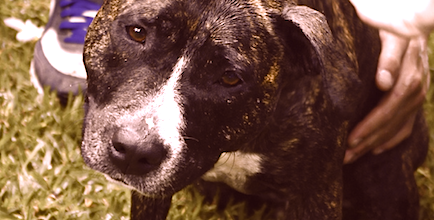Pyoderma in Dogs: Causes and Treatment
Yes, pyoderma is an infection, but no … it’s not infectious. Confused? Read this article to learn all about pyoderma in dogs.

Which of the following are signs of pyoderma in dogs?
- Spots and pimples
- Weeping skin sores
- Inflamed skin with hair loss
Actually, that was a trick question. All of the above are symptoms linked to canine pyoderma. This is a common condition, and most dogs have at least one episode during their lifetime, which is why is pays to be informed about it.
In this article, we’ll discuss …
- The causes of pyoderma in dogs
- The risk factors
- Treatment options
- Frequently asked questions about canine pyoderma

Don’t leave your pet’s safety to chance
Sign up for Petful recall alerts today.

What is Pyoderma in Dogs?
Let’s start at the beginning: What is pyoderma in dogs?
The clues are in the name: “pyo” (meaning pus) and “derma” (meaning skin). Pyoderma simply means infected skin.
Typically you’ll recognize this as either white-headed pimples on the dog’s belly or sticky sores that the dog constantly licks or scratches at.

A Closer Look at Pyoderma in Dogs
Vets tend to label pyoderma as either “superficial” or “deep.” Again, no great mystery here.
Superficial pyoderma in dogs is a mild pyoderma infection that’s limited to the skin’s surface, while deep pyoderma affects all layers of the dog’s skin and can be more difficult to deal with.
What Causes Pyoderma in Dogs?
Yes, canine pyoderma is an infection, but no … it’s not infectious.
Confused?
Let me explain: While the skin is infected, it’s not the sort of infection that’s passed on to other dogs or even people.
All skin carries with it a population of bacteria that sit harmlessly on the surface. (Yes, this is the same for people.) For healthy skin, this is no problem — the natural barrier of skin layers plus an on-the-ball immune system stop these bacteria from causing infection.
What causes pyoderma is when the skin can’t police itself properly and the bacteria invade. This might be caused by trauma to the skin surface, an overwhelming population of bacteria or weak skin immunity.
Thus, staph infections in dogs are the most common bugs linked to pyoderma. This is because staph bugs are a normal guest on dog skin.
Here are some potential causes of pyoderma in dogs:
- Skin trauma: This can be something as simple as being scratched by a thorn on a walk.
- Thin skin: The skin on the belly, armpits and groin is especially thin. This makes it easy for bacteria to get beneath the surface.
- Young age: Puppy pyoderma is common because puppies’ skin is thin and their immune system is weak.
- Dirty skin: Mud and dirt harbor bacteria. The dirtier the skin, the higher the bacteria count.
- Skin allergies: These weaken the skin. (See our expert guide to allergies in pets.)
- Skin folds: Haired skin rubbing against skin causes micro-trauma that sets the scene for infection. Breeds most at risk include Bulldogs, French Bulldogs, Pugs, Shar-Peis and American Cocker Spaniels.
- Drugs: Some medications, such as steroids, weaken the skin’s ability to fight infection.
- Parasites and ringworm: Parasites such as demodex mites or fungal infections such as ringworm weaken the skin.
- Poor health: Problems such as underactive thyroid glands or Cushing’s disease lead to poor skin immunity.
- Poor air circulation: Dogs with thick double coats or matted fur have poor air circulation over the skin. This encourages bacterial growth and pyoderma.
- Unsanitary conditions: A dog sleeping on soiled bedding or living in a dirty kennel is a case of pyoderma waiting to happen.

Pyoderma in Dogs Symptoms
Not all cases of pyoderma look the same. For example, puppy pyoderma looks like a load of white-headed spots or pustules, while skin-fold dermatitis is angry, red-looking with sticky skin.
Veterinarians talk about canine pyoderma in terms of superficial pyoderma and deep pyoderma.
This matters because superficial pyoderma often responds to an antibiotic ointment and medicated wash, while deep pyoderma needs the big guns thrown at it with a long course of antibiotic tablets.
Also, superficial pyoderma often has an innocent explanation, such as the dog got scratched on a walk. Deep pyoderma often needs an investigation to check out the dog’s general health and other risk factors.
But enough of the technical stuff — what will you see if your dog has pyoderma?
Symptoms of pyoderma in dogs:
- White-headed spots
- Sores that are usually weepy
- Inflamed patches of skin where the hair falls out
- Sticky skin folds
- Crusts and scabs
- A coat with a moth-eaten appearance
- Itchiness

Pyoderma in Dogs Treatment
Pyoderma dog treatment varies depending on whether the infection is superficial or deep, and in one spot or spread over the body.
Superficial Pyoderma in Dogs
This is the easiest form of pyoderma to sort out.
Usually it’s a single “hot spot” and can be treated with a topical cream or gel. The cream usually contains antibiotics and a steroid. This fights the infection while taking the heat out of the skin.
Your vet will clip the remaining hair from around the lesion, which helps air circulation (bacteria hate this). Bathing the sore with weak salt water is a good idea because this is a weak disinfectant and helps kill the bugs.
Then an antibiotic gel is applied to the cleaned skin twice a day.
It’s important to treat for at least 5 days even if the patch looks better after a couple of days. This reduces the risk of bacterial resistance developing to antibiotics.
Deep Pyoderma in Dogs
These guys have infection deep within the skin, and a topical cream just can’t penetrate deep enough to do any good.
These dogs need oral antibiotics to clean the skin from the inside out.
What is the best antibiotic for pyoderma in dogs? A popular choice is antibiotics from the cephalosporin family. These have good skin penetration and are good at killing staph infections. This contrasts with the penicillin-type antibiotics, which have been so widely used that resistance by skin staphs is widespread.
But antibiotics alone are only part of the story. Just as with superficial pyoderma, it’s important to get air to the skin and keep things clean.
This is all very well, but some cases respond and then the infection flares up again. What’s going on here?
These cases often have a problem that is metaphorically tying the dog’s paws behind their back when it comes to fighting infection. These are the dogs who have a health problem, such as underactive thyroid glands, which weaken their ability to keep staph infections at bay.
To get to grips with this, the vet will need to investigate and run diagnostic tests such as:
- Skin scrapes
- Skin biopsy
- Ringworm culture
- Screening blood tests
- Organ function tests (such as thyroid)
- Checks for Cushing’s disease
- Imaging to look for tumors that may be suppressing the immune system
Oh, and a final word on how to treat pyoderma in dogs. Deep pyoderma requires long courses of treatment. Six weeks is a good starting point, while severe cases need 2 or even 3 months.
In this video, Dr. Lindsay Butzer, DVM, explains more about how to treat deep pyoderma in dogs:
Frequently Asked Questions (FAQ)
Is pyoderma in dogs contagious?
No. Although pyoderma is an infection, it’s one that’s self-seeded. Think of pyoderma as being like a toothache — a dog doesn’t catch a toothache. Instead, it comes down to a lot of bad luck and dirty teeth.
How common is pyoderma in dogs?
It’s one of the more common canine issues, and so it is important to know the signs so you can get them treated quickly.
Is pyoderma in dogs fatal?
No, not usually. The exception would be the dog who has a serious underlying health problem, and the pyoderma is only one of many symptoms. However, this dog would be so sick anyway that a skin infection is the least of their worries.
Can I get pyoderma from my dog?
A normal, healthy person is not at risk of acquiring infection from their dog’s pyoderma. However, someone with a weak immune system, such as those on chemotherapy or the very young or old, are more at risk. If this sounds like you, then observe scrupulous personal hygiene around the dog and let your physician know of the risk.
Can pyoderma in dogs be cured?
If the risk factors remain in place, then there’s a risk of the pyoderma recurring further down the line.This isn’t that the infection didn’t clear in the first place, but more that the conditions for the perfect storm that created the pyoderma are still around.
For dogs who get repeated pyoderma flare-ups, this is where an investigation is a good idea. If the underlying factor that is feeding the infection can be eliminated, then there’s every reason to be optimistic that the pyoderma is permanently sorted. Of course, if the skin infection is down to dirty conditions or poor grooming, then improving this husbandry will mean a pyoderma-free dog. So for soft coats and supple skin, keep those coats clean and do everything you can to keep the dog in top health.
References
- Moriello, Karen A., DVM, DACVD. “Overview of Pyoderma.” MSD Veterinary Manual.
- Vitale, Carlo, DVM, DACVD. “Canine Superficial Pyoderma: The Good, the Bad and the Ugly.” DVM360. May 1, 2004.
- “Rilexine Tablets: Presentation.” National Office of Animal Health.
- Ward, Ernest, DVM. “Pyoderma in Dogs.” VCA Hospitals. 2009.
This pet health content was reviewed for accuracy by a veterinarian, Dr. Pippa Elliott, BVMS, MRCVS. It was last reviewed March 12, 2019 and updated July 4, 2024.
If you have questions or concerns, call your vet, who is best equipped to ensure the health and well-being of your pet. This article is for informational purposes only and is not a substitute for professional medical advice, diagnosis or treatment. See additional information.








